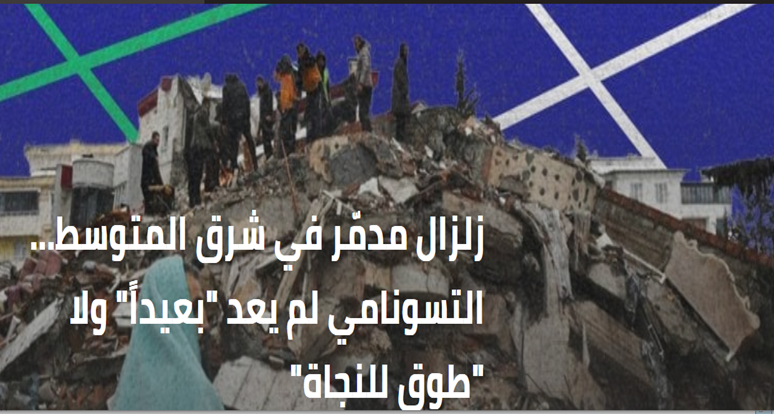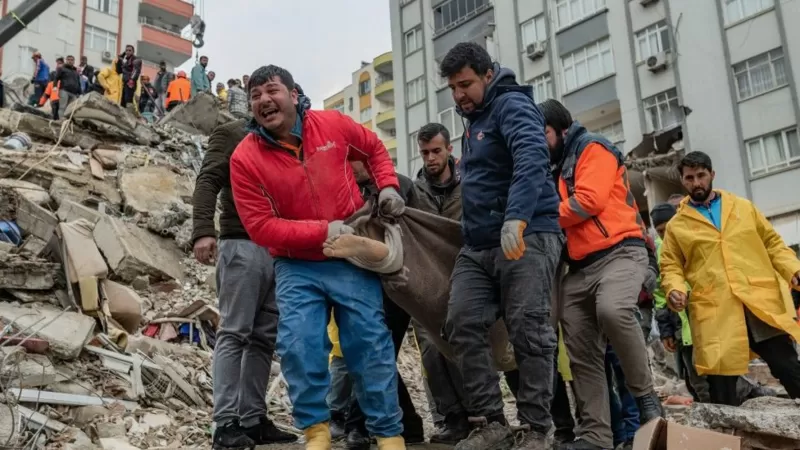A devastating earthquake in the eastern Mediterranean... The tsunami is no longer "far away" nor a "lifeline"

If you are a resident of the Middle East, you must have felt the violent earthquake that followed a strong earthquake that struck the region. And if you were a resident of Turkey, the epicenter of the earthquake, then your sense of danger was certainly greater.
At 4:16 a.m. today, Monday, February 6, 2023, an earthquake measuring 7.9 degrees on the Richter scale, according to the American Center for Seismology, struck Turkey. Multiple Syrian regions from north to south.
The state of alert has been raised to the fourth level in Turkey, a level that includes a request for international assistance. The other affected countries are Syria, Lebanon, Palestine, Jordan, Georgia, Armenia, and the United Kingdom.
The human losses are very large, with more than 1,000 dead, nearly 10,000 wounded, and thousands of buildings that have collapsed. Rescue teams in all affected areas are working to remove the rubble and try to reach the wounded and victims who are still under rubble.
Most countries in the world declared their readiness to send rescue teams and the necessary aid to the affected areas in Turkey and Syria.

on the earthquake line
Like any geological event, there are specialists who search and classify in order to open the field of knowledge to everyone. Earthquake lines have been identified in the world, and areas that are prone to earthquakes and earthquakes more than others are ?indicated. But what about the Middle East
Individually, we can improve a lot of what is going on around us today. Share with us what's going on in your head right now. Change, don't adapt.
The East African Rift Belt, extending from Syria, Lebanon, Palestine, Jordan and Turkey to Ethiopia and the Congo, is a line of frequent earthquakes.
The East African Rift Belt, extending from Syria, Lebanon, Palestine, Jordan and Turkey to the Red Sea Mountains to Ethiopia and the Congo, is a line of frequent earthquakes.
Globally, there are three other belts: the Alpine earthquake belt, the Atlantic Ocean belt, and the most dangerous of all is the Pacific Ocean belt, which causes three quarters of the earthquakes in the world, and passes from Japan to the coasts of the United States of America.

The balance of good deeds
When we mention any natural disaster, we always refer to the destructive damage, of course, and the victims that occurred, but natural disasters are not an absolute evil. For example, earthquakes, despite their destructive power within seconds, provide the earth with benefits that may last for hundreds of years.
According to the American geologist Frederick H. Bo, who spoke in his book "Volcanoes and Earthquakes" about the importance of earthquakes, because rivers and springs are only secondary phenomena that occur as a result of more important symptoms, and those events preserve our continents for us, while the seas and oceans remain low, as earthquakes constantly build mountains, to remain steadfast in their war Molars with rain, snow and sleet trying to break their tops and level them with the surface of the sea.
Those hidden forces are what are called crustal movements.
Sesmo, which means earthquake in Greek, if you follow what these seismograph machines monitor, you will be filled with terror, as that machine monitors the weakest tremors, most of which we may not feel, up to the strongest intensity, which would destroy entire cities.
According to Frederick, 150 thousand tremors can be felt in populated areas annually, and if we count them all, even the small ones; It may exceed a million earthquakes in one year. Thus, our land will be affected by tremors.
Escaping doesn't help
Should we run away? the correct answer; We cannot do that, for despite the enormous scientific power that modern man sought and gained from it, he stood helpless with the technology machines that he tried to invent in front of the earthquake. And suddenly.
The devices that science has reached can predict our heavy guest no more than half a minute ago, and people close to its center may hear a crackling sound followed by jolts back and forth or movements similar to sea waves, and here one feels himself as if he is prey to seasickness, and that the earth is not fixed enough for him to walk on, things might fall off the desk and the lighting from the ceilings if not secured enough.
Should we run away? the correct answer; We cannot do that, because despite the enormous scientific power that modern man sought and gained from it, he stood helpless with the technology machines that he tried to innovate in front of the earthquake.
The lower floors carry tremors clear to their occupants, and a person may feel as if the walls are moving from their place, while the upper floors have less movement, depending on the intensity of the earthquake, and it may sway in more severe cases.
Instead of thinking of feasible ways to escape, it is practical to make sure that we take cover and that alone helps, either under something solid or next to a strong concrete wall.
When we are done with the disaster, there are questions that must be put to the country’s officials who turn a blind eye to slums and manipulate the proportions of building materials, especially in poor areas where slums abound, and in countries where corruption is abundant, and here, of course, the countries of the region always come first. unfortunately.

After the earthquake is the worst
The fires that follow the earthquake may be more deadly to lives and property. In San Francisco in 1906, the earthquake caused only 5% of the recorded damages. Their homes were filled with dynamite so that they would not be fuel for the fire until the rain fell and the blazing flame was extinguished.
Separated water pipes, a special center for extinguishing fires whose hoses can use sea water, and additional underground water tanks, all of these measures that were completed later will ensure that the scenario does not recur in San Francisco if it is subjected to an earthquake again.
Also in Tokyo in 1923, a fire broke out in 136 separate places within half an hour of the start of the earthquake, so that people took refuge in a piece of open land on the bank of a river, where the fire enveloped them from three sides and rained them with sparks as if it were a hail, and suddenly, as in horror films, people heard a voice rising above all this And the sky darkened to witness a black cone hurricane, carrying sparks and setting fire to everything it encountered, and when the hurricane passed, the charred bodies of 13,000 people covered the ground.
The tsunami and earthquake that hit Japan in March 2011 is considered one of the most severe in the world, and it is also called the Great Tohoku earthquake
The tsunami would also flood cities and destroy them completely, and the tsunami and earthquake that struck Japan in March 2011 are among the most severe in the world, and it is also called the Great Tohoku earthquake, or the Great Sendai earthquake, and this disaster began with a strong earthquake that hit off the coast Northeast of the main island of Honshu in Japan, which led to great damage, and then began a series of huge tsunami waves that destroyed many coastal areas in the country, especially the Tohoku region, and caused a major nuclear accident at the power plant along the coast.

The Reconstruction Agency indicates that the number of confirmed deaths in this incident reached 15,894 in June 2016, and more than 2,500 people remain missing.
Over the past two decades, tsunamis have caused nearly ten percent of the economic losses resulting from disasters and undermined the development gains achieved, especially in countries located on the Indian and Pacific Oceans, according to United Nations Secretary-General Antonio Guterres, and Indonesia is one of the most vulnerable regions. Tsunami waves, due to its close location to what is known as the "Ring of Fire", where earthquakes and volcanic eruptions frequently occur.
Average tsunami?
There is a lot of talk in our region about the possibility of a large tsunami occurring in the next few years, but many scientists believed that it would be difficult for a tsunami to occur in the Mediterranean regions except in very rare cases, that is, when the earthquake’s strength reaches more than 9 degrees on the Richter scale, but this The reality may seem to have changed today, especially in the countries located in the western Mediterranean.
In August of last year, the journal Nature Communications published a study that identified for the first time the complex geometry of the subsurface active rift system of the Alboran Basin, located in the western Mediterranean between the Moroccan, Algerian and Spanish coasts, and described how it has moved over a period of time. 5 million years ago.
The results, which are based on high-resolution data, show that fault systems in the region absorb most of the deformation caused by the collision of the Eurasian-African plates. The results of the study, according to the researchers, are essential for re-evaluating the risks of earthquakes and tsunamis to coastal areas in the western Mediterranean, since most of the previous studies did not take into account the faults under the Alboran Sea due to the lack of data at the time.
The British Guardian newspaper, in a report published on July 23, 2022, quoted experts in the UNESCO, that the risk of a major tsunami occurring within the next 30 years, during which the height of the waves exceeds one meter, is close to 100%, and the waves will most likely hit large cities over Mediterranean coast such as French Marseille, Alexandria in Egypt and Istanbul in Turkey.
The Mediterranean region is no longer far from the dangers of tsunamis, as experts in the UNESCO confirm that the risk of a major tsunami occurring within the next 30 years is close to 100%, ?so what did they rely on
Scientists attributed these results to climate change, as sea level rise increases the risk of tsunamis in the Mediterranean Sea, as a 45-centimetre rise in sea level can double the risk of floods resulting from seawater sweeping into land by 1.2 to 2.4. times, and from 1.5 to 4.7 times, if the water rate increases by about 90 cm.
?What do we do when it happens
According to the Red Cross, there are several recommendations that if we do, we will avoid more risks in the event of earthquakes, the most important of which is to stay in a safe place until the earthquake ends. And if you can't take cover with something solid, take cover with a nearby wall and put your hands above your head and neck.
If you are in a shopping mall, stay away from windows and shelves that contain heavy items.
If you are outside, stay away from buildings and outside walls. And if you are driving, stop the car so that it does not block the road and stay away from bridges and everything that can collapse.
In all cases, you should avoid elevators, as the power may suddenly go out.
But if you are in a coastal area and it was hit by a strong earthquake, seek a safe area far from the beach and stay there until the official announces the possibility of returning.
After earthquakes, you should still be prepared for aftershocks, and try to provide assistance to those who need it.
Source: websites

